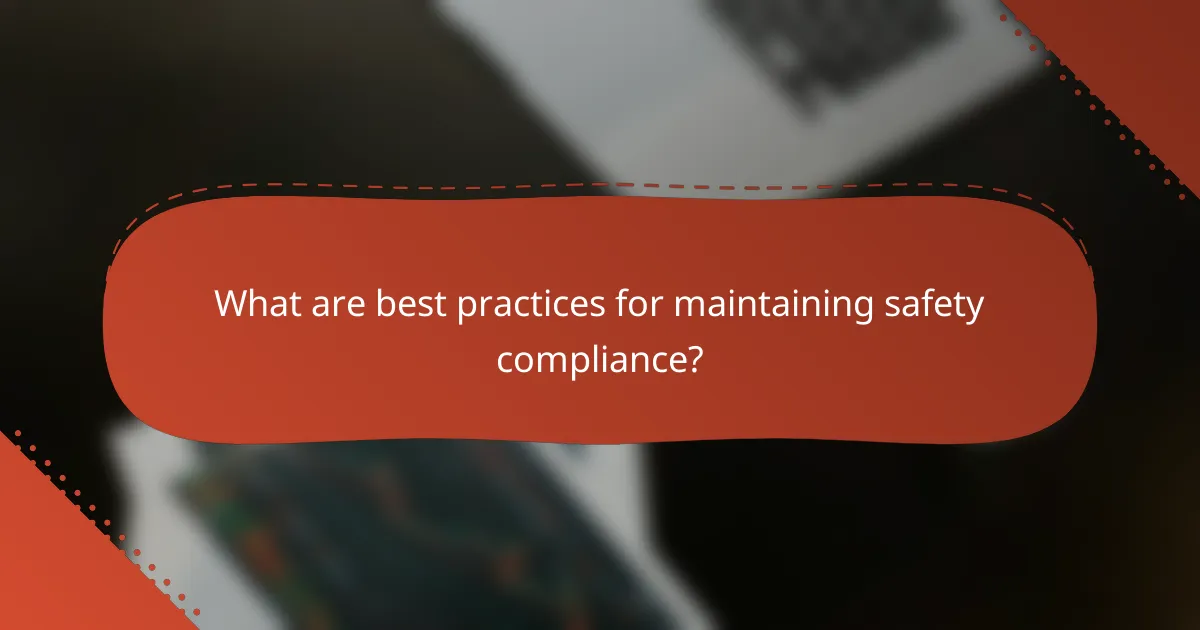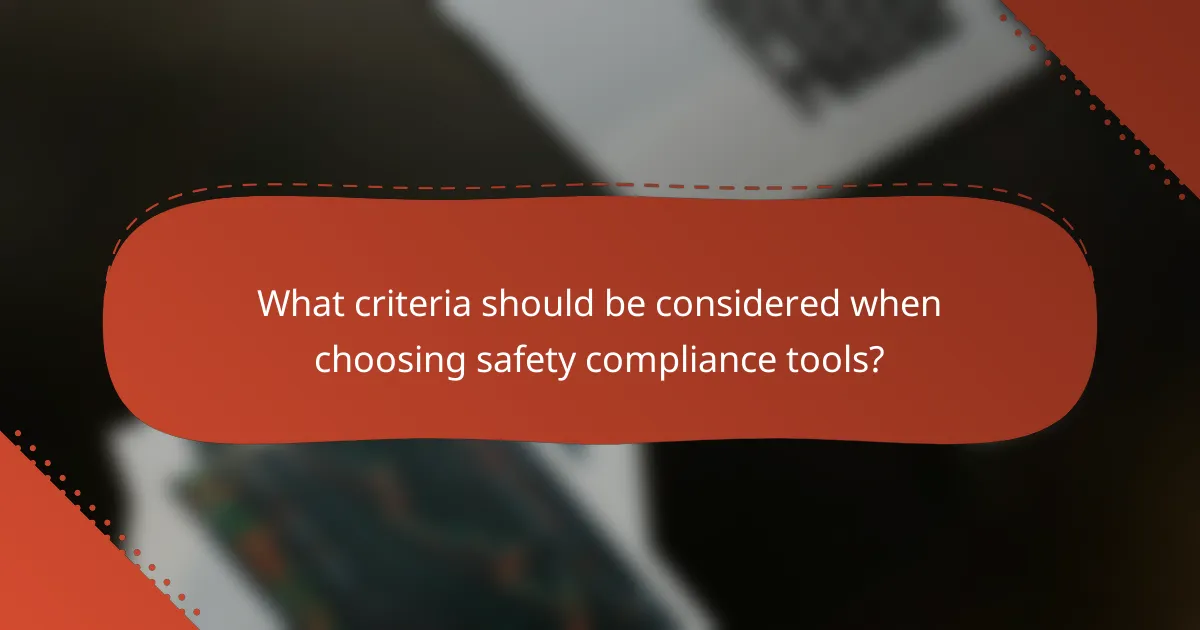Ensuring compliance with safety standards is crucial for minimizing risks and protecting employees in the workplace. This involves conducting systematic safety inspections to identify hazards and implementing best practices such as structured training and clear incident reporting. By adhering to these guidelines, organizations can foster a safer working environment and maintain regulatory compliance.

What are the key safety standards for compliance?
Key safety standards for compliance include regulations and guidelines that organizations must follow to ensure workplace safety. These standards help minimize risks, protect employees, and maintain a safe working environment.
OSHA Standards
The Occupational Safety and Health Administration (OSHA) sets and enforces standards to ensure safe working conditions in the United States. Employers are required to comply with OSHA regulations, which cover various aspects of workplace safety, including hazard communication, personal protective equipment, and emergency preparedness.
To maintain compliance, organizations should regularly conduct safety training, perform risk assessments, and keep accurate records of workplace injuries and illnesses. Failure to adhere to OSHA standards can result in fines and increased liability.
ISO 45001 Certification
ISO 45001 is an international standard for occupational health and safety management systems. It provides a framework for organizations to improve employee safety, reduce workplace risks, and create better working conditions.
Achieving ISO 45001 certification involves a thorough assessment of existing safety practices, employee engagement, and continuous improvement processes. Organizations should regularly review and update their safety policies to align with ISO standards, ensuring ongoing compliance and effectiveness.
ANSI Guidelines
The American National Standards Institute (ANSI) develops consensus standards that promote safety and health in various industries. ANSI guidelines cover a wide range of topics, including equipment safety, ergonomic practices, and safety training protocols.
Organizations should familiarize themselves with relevant ANSI standards applicable to their industry and integrate these guidelines into their safety programs. Regular training and updates on ANSI standards can help maintain compliance and enhance workplace safety.
Local Regulations
Local regulations vary by region and often complement national standards like OSHA. These regulations may address specific safety concerns relevant to local industries, environmental conditions, or community needs.
Organizations must stay informed about local safety regulations and ensure compliance to avoid penalties. Engaging with local safety boards or industry groups can provide valuable insights into specific requirements and best practices in the area.

How to conduct safety inspections effectively?
Conducting safety inspections effectively involves a systematic approach to identify hazards and ensure compliance with safety standards. This process includes thorough planning, using checklists, and regularly reviewing findings to enhance workplace safety.
Inspection Checklists
Inspection checklists are essential tools that help ensure all safety aspects are evaluated consistently. A well-structured checklist should cover key areas such as equipment safety, emergency procedures, and personal protective equipment (PPE) compliance.
When creating a checklist, consider including specific items relevant to your industry, such as machinery operation protocols or chemical handling procedures. Regularly updating the checklist based on past inspections and regulatory changes is crucial for maintaining its effectiveness.
Frequency of Inspections
The frequency of safety inspections depends on various factors, including the nature of the work environment and regulatory requirements. Generally, high-risk industries may require weekly or monthly inspections, while lower-risk settings might only need quarterly reviews.
Establishing a routine schedule helps ensure that inspections are not overlooked. Additionally, consider conducting unscheduled inspections to catch potential issues that may arise between regular checks.
Common Inspection Tools
Common tools for safety inspections include digital checklists, mobile apps, and specialized equipment for measuring hazards like noise or air quality. Digital tools can streamline the inspection process, making it easier to document findings and track compliance over time.
For physical inspections, tools such as safety goggles, measuring tapes, and first aid kits should always be on hand. Investing in proper inspection tools not only enhances safety but also demonstrates a commitment to maintaining a safe workplace.

What are best practices for maintaining safety compliance?
Best practices for maintaining safety compliance involve implementing structured training, regular policy evaluations, and clear incident reporting protocols. These practices help organizations meet safety standards and create a safer workplace environment.
Employee Training Programs
Effective employee training programs are essential for ensuring safety compliance. Regular training sessions should cover relevant safety procedures, equipment handling, and emergency protocols. Consider using a mix of in-person workshops and online courses to cater to different learning styles.
Additionally, training should be updated frequently to reflect any changes in regulations or workplace conditions. A good rule of thumb is to conduct training at least annually, or more often if there are significant changes in operations or new hires.
Regular Policy Reviews
Conducting regular policy reviews is crucial for maintaining safety compliance. These reviews should assess existing safety policies, ensuring they align with current regulations and best practices. Aim to review policies at least once a year or whenever there are significant operational changes.
Involve employees in the review process to gather insights and identify potential gaps. Document any changes made to policies and communicate them clearly to all staff to ensure everyone is aware of updated safety protocols.
Incident Reporting Procedures
Clear incident reporting procedures are vital for addressing safety issues promptly. Establish a straightforward process for employees to report accidents, near misses, or unsafe conditions. This process should include a dedicated reporting tool or form that is easily accessible to all staff.
Encourage a culture of transparency where employees feel comfortable reporting incidents without fear of repercussions. Regularly analyze reported incidents to identify trends and implement corrective actions to prevent future occurrences.

What criteria should be considered when choosing safety compliance tools?
When selecting safety compliance tools, consider factors such as cost-effectiveness, user-friendliness, and integration capabilities. These criteria help ensure that the tools not only fit your budget but also enhance usability and seamlessly connect with existing systems.
Cost-Effectiveness
Cost-effectiveness is crucial when choosing safety compliance tools, as it directly impacts your budget. Look for tools that offer a good balance between price and features, ensuring you get the necessary functionalities without overspending.
Consider both initial costs and ongoing expenses, such as subscription fees or maintenance charges. Tools that provide a clear return on investment, such as reducing compliance-related fines or improving efficiency, should be prioritized.
User-Friendliness
User-friendliness is essential for ensuring that all team members can effectively utilize the safety compliance tools. A tool with an intuitive interface reduces the learning curve and minimizes training time, allowing for quicker implementation.
Evaluate the tool’s design by considering factors like ease of navigation, accessibility of features, and availability of customer support. Tools that offer comprehensive tutorials or user guides can significantly enhance user experience.
Integration Capabilities
Integration capabilities determine how well safety compliance tools work with your existing systems. Tools that can easily connect with other software, such as project management or HR systems, streamline workflows and enhance data accuracy.
Check for compatibility with commonly used platforms and consider tools that offer APIs or built-in integrations. This ensures that data flows seamlessly between systems, reducing the risk of errors and improving overall efficiency.

What are the emerging trends in safety standards?
Emerging trends in safety standards focus on integrating advanced technologies and enhancing monitoring capabilities. These trends aim to improve compliance, streamline inspections, and promote best practices across various industries.
Technology Integration
Technology integration in safety standards involves using digital tools and software to enhance compliance and monitoring processes. For instance, companies are increasingly adopting cloud-based platforms for real-time data analysis and reporting, which helps in maintaining safety records and ensuring regulatory adherence.
Moreover, the use of artificial intelligence (AI) and machine learning can predict potential safety hazards by analyzing historical data. This proactive approach allows organizations to implement preventive measures, reducing the likelihood of accidents and improving overall workplace safety.
Remote Safety Monitoring
Remote safety monitoring utilizes sensors and IoT devices to track safety conditions in real-time, allowing for immediate responses to potential hazards. This technology is particularly beneficial in industries such as construction and manufacturing, where environments can change rapidly and hazards may arise unexpectedly.
By employing remote monitoring systems, organizations can reduce the need for on-site inspections, saving time and resources. However, it is essential to ensure that these systems are regularly maintained and updated to avoid false alarms or system failures, which can compromise safety efforts.
